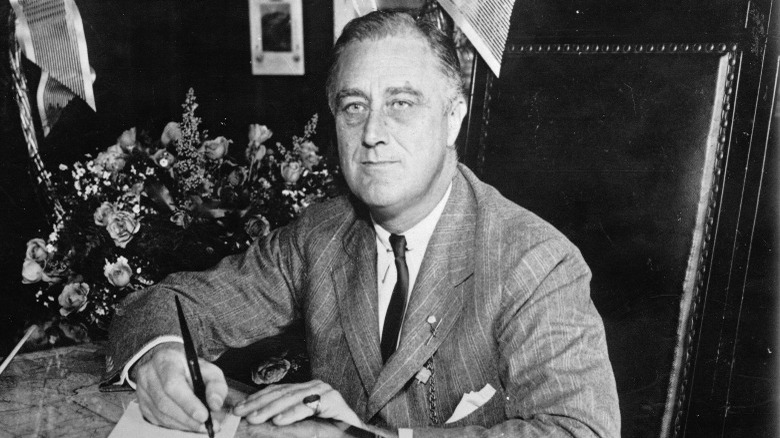Jenna Jameson's Guillain-Barre Syndrome Diagnosis Explained
Former adult film star Jenna Jameson revealed on January 10 that she likely has a rare illness, Guillain-Barré Syndrome (GBS). The experts at the Mayo Clinic, define GBS as "a rare disorder in which your body's immune system attacks your nerves. Weakness and tingling in your extremities are usually the first symptoms."
"The doctors suspect Guillain-Barré Syndrome and have started my IVIG treatment. I am in the hospital and will likely remain here until treatment is complete. I hope to be out of here soon," Jameson posted on her Instagram feed. IVIG, or intravenous immunoglobulin, is a treatment used for people who have a weakened immune system (via UK National Health Service). Jameson also added further clarification, noting the disorder was not a result of the COVID-19 vaccine.
Jameson presumably pointed out that her GBS diagnosis was not due to the COVID-19 vaccine because GBS has been reported as a rare side effect of the Johnson & Johnson vaccine. While more research is needed, the FDA website states that "there have been 100 preliminary reports of GBS following vaccination with the Janssen [Johnson & Johnson] vaccine after approximately 12.5 million doses administered. Of these reports, 95 of them were serious and required hospitalization. There was one reported death."
Symptoms and outlook
According to Jameson's partner, Lior Bitton, Jameson was initially not feeling well and vomiting for a couple of weeks, and so she went to the hospital. Following a clear CT scan, Jameson was released, but then she was unable to walk. "Her muscles in her legs were very weak. She wasn't able to walk to the bathroom. She was falling on the way ... and then I would have to pick her up," Bitton explained in an Instagram video.
The experts at Healthline explain that the cause for GBS remains unknown, but is typically associated with infectious illnesses such as stomach irritations and lung infections. The muscle weakness that Jameson experienced is commonly associated with GBS. Other symptoms of GBS include numbness and tingling that begins in your toes and fingers, which eventually move up to your legs and arms. These symptoms can progress and potentially lead to paralysis. Those with GBS can also experience extreme lower back pain, issues with bladder control, and challenges breathing, among other issues. Anyone can get GBS; however, it most commonly afflicts people 50 years of age and older (via Healthline).
While most people recover from GBS, the recovery period, in general, can take between 6 and 12 months (via Healthline). The FDA reports that between 3,000 and 6,000 Americans are diagnosed with Guillain-Barré every year.
Diagnosis
While there are a number of symptoms associated with GBS, including those experienced by Jenna Jameson, doctors aren't limited to just analyzing symptoms. There are also certain tests that can help to confirm that you have the disorder.
According to Cleveland Clinic, one of the tests your doctor may consider is a spinal tap. During this procedure, also known as a lumbar puncture, your doctor will insert a small needle into your back to extract a sampling of the fluid that surrounds your spinal cord called cerebrospinal fluid. The doctor will then analyze the fluid to determine if you have any infections that resemble GBS or if analysis of the fluid more specifically indicates a GBS diagnosis.
Another test that can help diagnose GBS is called electromyography (EMG). This is a test that you need to take in two parts that investigates how healthy your nerves and muscles are and how well they are functioning. An EMG is helpful in testing for GBS since a primary indicator of GBS is nerve damage (via Cleveland Clinic).
Treatment
Jenna Jameson revealed on Instagram that she is receiving IVIG treatment for her possible GBS, which is a common treatment for the disorder. According to the experts at Johns Hopkins Medicine, another potential treatment is plasmapheresis. During this procedure, the doctor removes your plasma and replaces it with other fluids. While undergoing this procedure, the doctor will also remove antibodies as a way to minimize GBS symptoms. While IVIG and plasmapheresis tend to be the primary approaches, there are also other possible treatments. Some research already indicates that acupuncture may also be helpful in treating GBS, as highlighted in the Journal of Traditional Chinese Medicine Sciences (via ScienceDirect).
Physical therapy in a rehabilitation setting may also be part of treatment for GBS as a way to help rebuild muscle use and strength (via National Institute of Neurological Disorders and Stroke). These treatments may be specially designed to a patient's needs based on where the GBS has affected the body, if the patient has developed any blood clots, or other specific issues. And occupational therapy can help patients work towards returning to their regular daily life activities.
Unfortunately, there is no known prevention for GBS as of this reporting, but health experts continue to work on finding ways to defend against GBS and develop better treatments (via Cleveland Clinic).
Other notable figures who have had Guillain-Barré Syndrome
While GBS is a rare disorder, Jenna Jameson is not the only well-known figure known to have the condition. Perhaps the most world-famous example of someone that is now believed to have had GBS is President Franklin Delano Roosevelt. Originally diagnosed with polio, some health experts now believe it is possible that polio was an incorrect diagnosis.
According to Science, a report in the November 2003 issue of the Journal of Medical Biography suggests that Roosevelt's symptoms support a GBS diagnosis. "Immunological pediatrician Armond Goldman of the University of Texas Medical Branch in Galveston now says FDR's symptoms are more concordant with Guillain-Barré syndrome, a bacterially induced autoimmune disease. For example, polio paralyzes limbs unevenly and doesn't move up the body as happened with Roosevelt. The intense pain he felt when people touched his paralyzed legs isn't commonly seen in poliomyelitis." Additionally, as the report detailed, polio would typically affect children as opposed to adults.
As far as other notable figures who have been afflicted with GBS, beloved actor Andy Griffith revealed in 1983 that he had the disorder. After undergoing physical therapy, however, Griffith made a full recovery and was able to return to acting (via Los Angeles Times). Former defensive tackle for the Chicago Bears, William "Refrigerator" Perry, also had GBS (via Sporting News).





